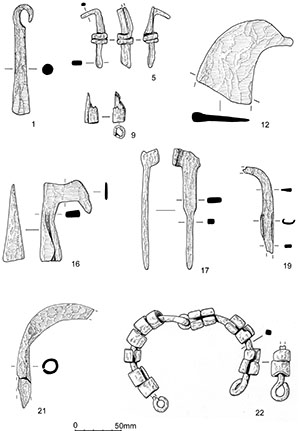
This small group of objects, twenty-two in all, comprises the ironwork that can with some certainty be linked to agricultural practices, that is, objects with a specialised function (Table 66). The agricultural tool kit of the Romans would undoubtedly have included general-purpose knives and other blades that could have had other purposes, which have been subsumed in this report within the general tool category. Many agricultural implements, such as rakes, could have been made entirely of wood, with no inorganic components. Iron rake prongs are infrequent finds from Roman sites, but were probably more commonly used than the archaeological record suggests, since they are very difficult to identify when broken. Some of the bar fragments from Elms Farm could be rake prongs, but they have not been included here.
All the objects in this category from dated contexts are Roman. The artefacts thus provide no evidence for Late Iron Age agricultural practices at Elms Farm.
The group includes objects associated with both animal husbandry (ten ox goads and an animal bell clapper) and arable farming (bladed tools such as pruning hooks). Also in this category are two slave shackles; while they are only loosely connected with animal husbandry, it seemed more appropriate to place them here rather than in, say, items of personal adornment.
The following objects are iron.

This clapper is from a relatively large bell, which was probably an animal bell.
1. Bell clapper, comprising a slightly tapering cone with the tip bent into a loop. The loop was damaged in antiquity. L. 119mm. SF1184, Pit 4429, Group 741, Area K, Period 5
The ox goads have been classified using Rees' typology (Rees 1979, 75). Type I is a spiral ring with a point at right-angles; Type II has a single ring, and can occur in either iron or bone. No bone goads were found at Elms Farm. Rees notes that Type I is commonest, and seven out of the ten examples from Elms Farm are of this type. They occur throughout the Roman period. Type II, in particular, can be Iron Age, but there were no ox goads at all from Iron Age contexts at this site.
2. Not illustrated. Type I, probably incomplete, with just over one coil surviving, and the point broken. L. 30mm, external diam. 20mm. SF3364, Layer 5951, Group 606, Area I, Period 3B
3. Not illustrated. Type I, probably with two coils. The point is missing. L. c. 32mm, diam. 18mm. SF8257, Fill 5964, Pit 13873, Group 445, Area J, Period 6
4. Not illustrated. Type 1, with three coils. A good example, complete though broken. L. 47mm, external diam. 17mm. Machining layer 7000, Area G
5. Type I. It has a tapering iron strip jammed into the hole, with the tip turned over, adjacent to the point of the goad. The point of the goad and the broader and of the strip were broken in antiquity. With the point turned over, it seems unlikely that the strip could have got into this position accidentally, but it is not clear whether it was done for a specific purpose. Ox goad L. 38mm, diam. 17mm; strip L. 79mm, section 11x5mm-4x4mm. Fill 7140, Pit 7139, Group 851, Area G, Period 3
6. Not illustrated. Type I, incomplete, with half a coil and the prong surviving. L. 26mm, external diam. 20mm, internal diam. 14mm. Context 11468, Group 1244, Unknown 11733, Area N, not phased
7. Not illustrated. Type I, with two coils. The point has broken off. External diam. 16mm, internal diam. 12mm, L. 20mm. SF6435, Fill 15233, Pit 15232, Group 471, Area M, Period 6
8. Not illustrated. Type I, with two coils. Almost complete, but flaking. L. 55mm, external diam. 15mm, internal diam. 10mm. Fill 24198, Pit 24197, Group 696, Area M, Period 4
9. Type II. The socket contains mineralised wood, clearly the remains of the shaft. The wood extends most of the way up the prong, to within 4mm of the end. L. 31mm, diam. 14mm. Fill 4994, Pit 4989, Group 1147, Area K, not phased
10. Not illustrated. Two fragments, forming c. 50% of a Type II ox goad There is mineralised wood in the socket, possibly associated with the object. Diam. c. 17mm, L. 30mm, ferrule depth 15mm. SF2299, Cleaning layer 5603, Area I, not phased
11. Not illustrated. Type II, complete. Diam. 15mm, L. 23mm. SF8270, Fill 8153, Pit 8155, Group 836, Area E, Period 5
12. The tip of a large bill, with a 'beaked' point. In good condition. The width is variable, and the overall form may have been similar to Rees 1979, fig. 226. L. 95mm, max. W. 63mm. SF6631, Fill 15463, Posthole 15466, Group 688, Area M, Period 3
13. Not illustrated. Fragments of a socketed bill, with the socket at an angle to the blade. It is very fragmented, and the surface is flaked. Little of the socket survives, but it was open, and probably squared rather than rounded. There was a short, rather slender, neck between the socket and blade. Very unusually, the open side of the socket is in the plane of the blade. The form of the blade is uncertain, as much of it is missing. It is in two main parts, the smaller of which is only presumed to be part of the object, since it does not join. It probably had a rather narrow blade (as Rees 1979, fig. 227b) rather than a chopper-type blade. The cutting edge is very blunt. Original blade L. >270mm, max. surviving blade W. 75mm. SF6262, Cleaning layer 14765, Area L, not phased
14. Not illustrated. Blade tip, probably from a scythe. The back is thickened, and the blade flat on one face. The other face of the blade changes angle halfway across. The tip is blunt. This is likely to be the tip from a heavily backed blade such as a scythe, where the presence of a sharp tip is unimportant. L. 33mm, max. W. 13mm. Fill 11354, Pit 11347, Group 665, Area N, Period 3.
15. Not illustrated. Blade fragment; parallel sided, with the back thickened on one face only. One end has a fresh break. Probably part of a scythe blade. L. 71mm, W. 27mm. SF4824, Fill 12234 Ditch 12236, Group 960, Area R, Period 3.
16. Small pruning hook, socketed, complete as buried, but very mineralised. There is possibly a nail hole in the socket. The shape of the hook is unusual, with an almost square top, and a straight edge to the blade, which is rather blunt. The tip is a small rounded projection almost at right angles to the blade. L. 87mm. SF6246, Fill 14687, Pit 14686, Group 1000, Area L, not dated
17. Reaping hook tang. The form is as Manning 1985a, F36, with a small flanged socket and a long external tang, in this case with a distinct step. The flanges are damaged and incomplete. L. 127mm, W. of socket 29mm. SF3398, Cleaning layer 6552, Area H, not phased
18. Not illustrated. Tang, probably from a small reaping hook with a flanged socket, as Manning F36. Only part of the flange survives, and it is somewhat distorted. L. 64mm, socket diam. c. 25mm. SF5928, Fill 15150, Pit 15231, Group 699, Area M, Period 5
19. 'Pruning' hook. A very small hook with the blade broken, and the remains of a flanged socket and external tang. This was a delicate little blade, too small for heavy work, and verging on a 'miniature', though not substantially smaller than some of those illustrated by Rees (1979). L. 95mm, W. 14mm. SF6244, Cleaning layer 14594, Area L, not phased
20. Not illustrated. Thin, crescentic blade fragment, with the edge on the concave side, narrowing towards the incomplete tip. Probably part of a small pruning hook. L. 75mm, max. W. 19mm. SF4653, Layer 10496, Group 841, Area F, Period 5
21. Small socketed blade, with recent damage to the socket, length incomplete. The blade is curved, and the tip is missing (an old break). The socket is probably a closed flange, with the split along the outer edge (i.e. in line with the back of the blade), which is unusual. There are traces of mineralised wood in the socket. L. 125mm, blade W. 24mm. SF2765, Cleaning layer 5543, Area J, Period 5-6. (Cleaning layer along roadside)
22. Two shackles, both open when found. They were placed on top of each other, described by the excavator as looking 'like a spring'. Each consists of two curved rods with square sections, joined by a simple looped hinge, the other ends also being looped. One was cleaned, and is illustrated. It was in two pieces when found, the larger of which had cracked during burial, and broke during conservation. One looped terminal was detached, and does not join. Each half had six penannular rings threaded on it, made from strips of variable width, 6-16mm. The unillustrated shackle was almost identical, but had only five rings on each half. Internal diam. of shackle 84mm, Ring diam. 20mm. With the rings in place, the shackle has an effective internal diameter of 64mm. SF6670, Fill 15574, Pit 15573, Group 691, Area M, Period 3
The only other iron object from the pit (excluding nails) is a ring (SF6673, Fill 15574). It seems unlikely that this was part of the shackle assemblage, as it is almost as large as the shackles, with an external diameter of 73mm, and an internal diameter of 60mm.
Such shackles have been interpreted on occasion as animal fetters rather than slave-shackles, and Thompson (1993, 134ff) accepts some of the ancient examples as animal fetters. One particular difference is that slave shackles would have been padlocked, an arrangement unnecessary for hobbles. This element is missing on the Elms Farm examples, but they are very similar in form to definite slave shackles, and this is their most likely function. The presence of rings on the shackles is very unusual; Thompson (1993, 110) cites only one parallel, from Vertault in Gaul (Cote-d'Or). The latter example is similar in size to the Elms Farm shackle, and is interpreted as a manacle (Thompson 1993, 59) gives the average diameter of a human male wrist as 65mm). Slave shackles occur in Britain from the Iron Age onwards, and the two from this site could possibly be Iron Age, though an Early Roman date is more likely.
Cite this as: Tyrrell, R. 2015, Salt briquetage, in M. Atkinson and S.J. Preston Heybridge: A Late Iron Age and Roman Settlement, Excavations at Elms Farm 1993-5, Internet Archaeology 40. http://dx.doi.org/10.11141/ia.40.1.tyrrell11
A large assemblage of fragments of the distinctive ceramic equipment used for late prehistoric and Early Roman salt processing was recovered from the site. The total number of fragments was 6641, weighing 219.7kg. The proximity of the excavations to the coastal sites of production may mean that the settlement was being used for the re-drying and repacking salt for transport inland, but meaningful patterns of deposition are obscured by later activity. Although Maldon is the site of a small, modern sea salt factory, there is no continuity with the earlier salterns.
Initial macroscopic examination allow the division of the material into three types. The fine, silty clay matrix did not appear to differ much between the types. The differences were more visible in the amount of tempering material mixed with the clay, although this does not seem to have any great significance. Fabric A appears in relatively small quantities, tailing off at the end of the Early Roman period. Similar proportions of the other two fabrics appear throughout the life of the site, and all three fabrics were used for the various forms of briquetage.
Fabric A: This contains abundant vegetable temper, mostly burnt out, giving a vesicular appearance and a hackly fracture. The organic material includes seeds and looks as if it has been chopped fairly short, unlike the longer strands of the organic inclusions of the kiln material from this site (Kiln Fabric A). The vesicles often contain a white deposit. The surface occasionally has a cream coloured deposit. The material is light in weight, compared to a pottery sherd of a similar size. The colour is variable, predominantly a reddish orange, often with a pinkish/mauve tinge, and sometimes with a reduced core. Glazing caused by salt is also present on some sherds. There was 5.760kg of this fabric present.
Fabric B: This is a softer, denser fabric than A, and has less abundant vegetable inclusions but is otherwise very similar. There was 145.132kg of this fabric.
Fabric C: Little vegetable tempering is used in this fabric, resulting in greater density. The colour is browner than the other fabrics. There was 68.770kg of this fabric.

The 6641 fragments of briquetage were divided into pieces related to vessels and pieces from supports, firebars and other shaped objects (Figure 511). This classification is based on the work of de Brisay and her colleagues since many of the Elms Farm forms are present in their typology of Essex briquetage (Fawn et al. 1990, 69). Lane and Morris's recent work in Lincolnshire (2001) has shown that there are differences in style between the Lincolnshire salt equipment and that from Essex sites. The triangular firebar for instance, is absent from the Lincolnshire assemblages, as the fire-pits there were bridged with sub-rectangular slabs.
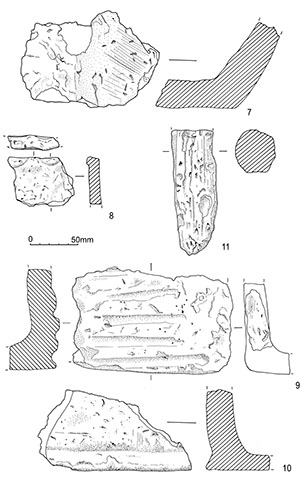
Some 22% of the fragments were vessel wall and rim sherds, whose fragmentary nature makes understanding of the complete form difficult. However, these are almost certainly pieces of hand-built, rectangular containers with rounded corners and near vertical sides (Figure 513.7). Similar pieces have been found in Late Iron Age and Early Roman Red Hills (salt production sites) in Essex, such as that at Peldon, about 18km from Elms Farm (Fawn et al. 1990, 11). There are no examples of the pot shaped briquetage vessels used in the early to mid-Iron Age, such as those from Gun Hill, West Tilbury (Drury and Rodwell 1973, figs 13.25 and 13.26). The general proportions and capacity of the trough-like rectangular vessels can only be guessed at, since no complete ones have yet been found in Essex. Elms Farm produced no complete profiles, so it has to be assumed that they could be similar to a vessel fragment recovered from Peldon, which was at least 190mm deep. The Elms Farm vessel walls range from 10mm up to 43mm in thickness, with an average of 26mm. They are similar, in this respect, to examples from the north-east Essex coast (Fawn et al. 1990, 11).
The vessel rims, with one exception (Figure 513.8), are flat and roughly knife-trimmed, unlike, for example, fragments from Kelvedon, Essex (H. Major, pers. comm.), which are decorated with oblique finger impressions. Deep finger indentations decorate the vessel rims from Peldon (Fawn et al. 1990, 12). Elms Farm's only decorative rim is crimped into a slightly wavy line by thumbing. The exterior surfaces of the containers are roughly wiped upwards from the base and in many of the pieces deeply impressed vertically by the makers fingers (Figure 513.9).
A substantial proportion of the assemblage (38%) is made up of fragments with no surfaces, and a further 39% have only one finished surface surviving. Judging from their general morphology and size these pieces are from damaged vessel walls. The material with a single surface probably came from vessels whose inner surface had gone. Morris (Lane and Morris 2001, 52) comments on the damage to the inner surfaces of material from the excavation of Cowbit, Lincs, interpreted as the result of scraping the salt crystals from the sides of the vessels.
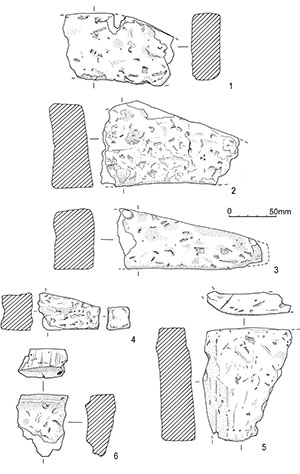
The assemblage includes sixty-one fragments (22.5kg), from elongated triangular firebars. Although none of the pieces is whole, it is possible to say that all but one of Elms Farm examples are from bars that had blunt ends and a truncated apex (type e; Fawn et al. 1990, 69) (Fig 512.3 and 512.4). The single example with a pointed apex (Figure 512.1) was found in a context dated to the same period as those with blunt apices, so they appear to have been in use at the same time.
The dimensions of the bars appear to be fairly uniform. There were no complete lengths, 150mm being the maximum, and the average thickness was 41mm. The maximum height of the apex is 77mm and across the tip is 38mm. The use of these objects is not fully understood. It has been suggested (Fawn et al. 1990, 23) that these triangular objects were used as horizontal supports on which the evaporating vessels rested over the heat, similar to the way firebars are used in a pottery kiln. Further evidence for this theory was given by the finding, at the Red Hills at Peldon and Goldhanger VIII and X, of hearth-lining fragments with the impressions of the ends of firebars preserved in the fabric. Although there is nothing on the Elms Farm fragments, to indicate whether they were used in this way, there are a number of glaze-like salt splashes on the surfaces of the objects, so they were used in positions of considerable heat. Triangular firebars, with some minor differences, are known from a number of Essex sites but the work recent on Lincolnshire saltings did not produce any similarly shaped briquetage. The containers from these sites appear to have been supported by roughly cylindrical pedestals.
A number of other forms of briquetage are present in the assemblage. There are six fragments of roughly finished cylindrical objects and two damaged T-shaped tops. The excavation of the Red Hill at Osea Road, Essex (Fawn et al. 1990, 12), produced a similar object, or 'pedestal' with a T-shaped top and a splayed base. Another piece from the same site has the pedestal base luted onto a rectangular pad. The T-shaped tops of these are damaged in the same way as the Elms Farm pieces (Figure 514.12-14), presumably by the weight of the containers resting on them. Exactly what functions these pedestals performed remains conjectural in the absence of in situ evidence, but, as with the firebars, the presence of salt splash 'glazing' suggests that these objects were in contact with heat. It is assumed that they supported the evaporating vessels over the fire in some way. The average diameter of the Elms farm pedestals is 50mm; there are no complete lengths, the longest fragment measuring 127mm. The few complete Essex examples range from 200 to 300mm long.
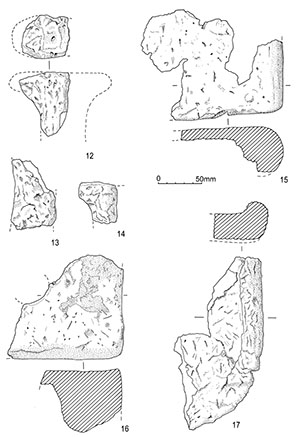
Thirteen fragments of rectangular slabs or blocks were also recovered (Figure 514.15-19). With two exceptions, the blocks have rounded edges and right-angled corners, one partially smoothed and one broken surface. This is similar to the pedestal base pad from Osea Road, and although the Elms Farm pieces have no trace of the pedestal, this may be how they functioned. They have no salt splashing on the surfaces but they are very friable.
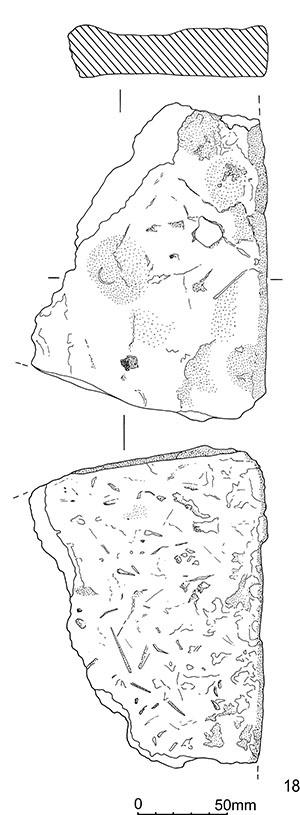
The only piece of block (Figure 515.18) with both faces smoothed flat has a rounded corner with an angle of 80°. This may be part of a sub-triangular wedge similar to those found at Wigborough and Langenhoe (Fawn et al. 1990, 13). Exactly what part they played in the salt production process is still not understood (Fawn et al. 1990, 27), although it has been suggested that they were used for shaping clay, or for scraping the salt from vessels. However, this incomplete piece adds nothing to the discussion.
Lastly, there is a fragment of briquetage with one straight and one rounded edge, one smoothed, flat surface and one uneven (Figure 516.19). The uneven surface has deep, irregular finger-impressions. The function of the object is obscure.
1. The middle section of a firebar. The apex of the triangle has been trimmed off. Fabric B. Fill 6314, Ditch 6313, Group 4001, Area H, Period 4 (Figure 512)
2. The middle section of a firebar showing the apex. Fabric C. Fill 19150, Pit 19149, Group 658, Area P, Period 3
3. Part of a firebar, with some damage to the tip. Fabric B. Fill 15683, Pit 15687, Group 691, Area M, Period 3
4. Firebar tip. Fabric B. Fill 13681, Pit 13640, Group 594, Area I, Period 3
5. Plain, knife-trimmed vessel rim. Fabric B. Fill 7166, Pit 7118, Group 852, Area G, Period 3
6. Plain, knife-trimmed vessel rim, with a groove below the rim, possibly for lid seating. Fabric B. Fill 9749, Pit 9750, Group 784, Area D, Period 3B
7. Curved vessel corner. Fabric B. Fill 7166, Pit 7118, Group 852, Area G, Period 3 (Figure 513)
8. Decorated vessel rim. Fabric B. Fill 7362, Ditch 7322, Group Area G, Period 2
9. Vessel wall fragment with deep finger-wiped grooves and an unusually angular corner. Fabric B. Fill 4976, Pit 4733, Group 729, Area K, Period 3
10. Base of a straight-sided vessel. Fabric C. Fill 19150, Pit 19149, Group 658, Area P, Period 3
11. Pedestal stem. Fabric B. Machining context 4000.
12. Pedestal stem slightly curved just below the damaged T-shaped top. Fabric B. Layer 9468, Group 1303, Area D, not dated (Figure 514)
13. Pedestal stem, slightly curved, with part of the damaged T-shaped top. Fabric B. Layer 9468, Group 1303, Area D, not dated
14. The tip of a pedestal top. Fabric C. Collapse 7598, Group 9020, Area G, not dated
15. A block or slab corner. One edge has been knife trimmed flat and the other moulded round. Owing to poor preservation, the original thickness cannot be established. Fabric B. Fill 23090, Pit 23124, Group 236, Area N, Period 2B
16. The corner of a thick block-shaped object, with a hole or circular depression, 115mm in from the corner. Fabric C. SF8065, Fill 4286, Pit 4285, Group 62, Area K, Period 2
17. A block-shaped object or possible pedestal pad. Fabric B. Layer 23047, Group 3086, Area N, Period 3
18. A block or slab corner with both faces wiped smooth and a knife-trimmed edge. Fabric B. Fill 8597, Pit 8594, Group 222, Area P, Period 2 (Figure 515)
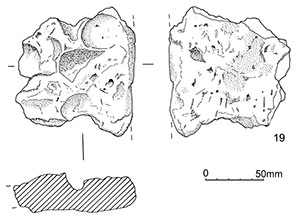
19. A block or slab edge with deep finger impressions on one face. Fabric B. Fill 3752, Pit 3751, Group 889, Area W, Period 3
No primary salt processing sites were identified during the excavations, and it may be assumed that processed salt was being brought to the site from elsewhere. The nearest known Red Hills on the Blackwater Estuary are approximately 3km away at the Maldon Landfill site, south of the modern town, and 4km to the east, at Osea Road. While salt must have been a bulky commodity to transport, this may have been less of a problem if the coastal routes were used. It could be that containers of salt were ferried to Elms Farm in small punt-type vessels and possibly secondary drying, re-packaging or storage carried out.
This, however, does not explain the presence of kiln furniture. If it is accepted that the initial processing work was carried out in the marshes during the summer months (Rippon 2000, 45) there is little evidence of structures associated with salt making sites so it seems unlikely that the salt-workers lived out by the drying ovens and evaporating tanks permanently. They probably had homes in the settlements further inland, such as that at Slough House Farm and Elms Farm. Perhaps all the equipment was brought back to a settlement at the end of the season and broken bits left behind with the settlement's rubbish when the workers returned next season. Material left out on the marshes would not have survived high tides and frosts. Whether the equipment would have been carried much farther inland than the nearest settlements can only be speculation.
Ceramic vessels would seem very heavy and unwieldy containers in which to transport salt overland. Tightly woven baskets made from marsh grasses, or leather would be much lighter (Lane and Morris 2001, 460) and more easily handled but would leave no trace in the archaeological record. However, briquetage is found in varying quantities at sites much further inland than Elms Farm. Barford (Fawn et al. 1990, 79-80) records seventeen sites, including three in Hertfordshire, one in Suffolk and a doubtful one in London. Sealey (1995, 77) lists six more Essex examples, to which Ardleigh (Major 1999c, 157), Kelvedon (H. Major, pers. comm.) and Maltings Lane, Witham (Tyrrell Unpub) should be added. Various suggestions have been made as to the reasons for briquetage being found inland. Barford (Fawn et al. 1990, 79-80) speculates that the salt could have been traded in the briquetage vessels, but this is a very bulky method, and does not explain the presence of kiln furniture at some sites, such as Kelvedon. He also offers accidental inclusion of the material in the salt transport containers, and the use of salt impregnated briquetage as salt-licks for cattle. Sealey (1995, 69) doubts that the material would have had enough salt content to make it suitable for such a use. He sees the pieces as the result of secondary drying of salt that had become inadvertently damp during transport. This could at least explain, to some extent, the presence of some kiln furniture.
The presence of seventy-one fragments of brick and tile with salt splashes is discussed in the tile report in this volume. Oven 15894, in Area M had four brick fragments with splashes, and salt splashes were also evident in hearth construction 9573 (Area D, Period 3) and Oven 20137 (Area L, Period 6). It is possible that these tiles were part of ovens used for processes involving salt, perhaps secondary salt drying. Possibly spillages would occur before the containers were put over the heat. A total of 2.373kg of briquetage was found in nine hearths, none of which had salt-splashed tiles. These small quantities of briquetage appear to have been incidentally rather than deliberately incorporated in the hearths.
Salt would have played an important part in the preservation of food particularly meat and fish, and it is likely that it was being used in the settlement for these purposes as well as being sent on to markets in the local towns such as Chelmsford, Witham and Kelvedon. Briquetage has been found in all these places. There is evidence, in the form of a number of ceramic strainer vessels that cheese-making was carried out at Elms Farm, another culinary process that involves salt.
A survey of the features producing briquetage reveals an extensive list of types of deposit, all but a few of which contain material that must have been lying around the site and represent the disposal of rubbish. The largest proportion, 42% (by weight) of the pieces, came from pits. The peak of this deposition seems to be around the late 1st to mid-2nd century AD. It is certainly not clear from the distribution of briquetage whereabouts on the site activities involving salt may have been carried out.
A plot of briquetage finds across the site shows distinct gaps where areas were not excavated, for example between Areas L, M, P and Q. There is a noticeable lack of briquetage in Area J, the temple area, which is not a part of the site you would expect to be used for either salt drying or waste disposal in rubbish pits. The quantities of material do appear to intensify around Areas H and I and thin out towards the north-west corner of the site. This mirrors the density of occupation to a large extent. While there are some slight increases of quantity around hearths and ovens, it is difficult to know whether these fragments of briquetage were used for salt processing or just as useful building materials.
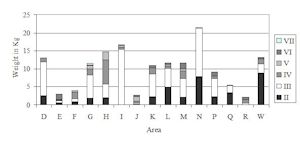
If these differences are looked at by period across the site (Figure 517), slightly different patterns emerge. In the Late Iron Age the weight of material is greatest in Areas W and N, whereas in the late 1st to 2nd century the focus changes to Areas I and N with almost none from W. By the mid- to Late Roman period, Area H is the focus of activity, though it ceases to be before the end of the Roman period, when Areas M and E predominate.
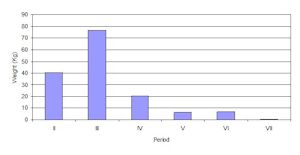
The quantities of material reach a peak during Late Iron Age and Early Roman period when the Red Hills were fully in operation (Figure 518). The dating from Red Hills (Fawn et al. 1990, 37-9) suggests that production was very limited after c. AD 200. The quantities at Elms Farm reduce from 77kg in Period 3 to 20kg in Period 4 (mid-2nd to 3rd century), and a further drop in Period 5, with a slight increase in Period 6. The Period 5 and 6 material at least may be residual. The pattern of deposition in Period 5 follows that of Period 6, with most coming from Area H, although there is no briquetage at all from this area in Period 6. The largest groups of Period 6 briquetage are from Areas E and M. However, the Period 6 briquetage in Area E is almost all from a single feature (Pit 8152), and over half of the Period 6 briquetage from Area M is from a single pit (24456); both features have considerable amounts of residual pottery.
The Elms Farm briquetage, despite the size of the assemblage, does not add much to our understanding of the economy of the Essex salterns. The settlement could have been controlling the harvesting of shellfish, seaweed, wildfowl, and the grazing on the local marshes as well as salt boiling but the material does not help towards understanding any of this. Most of the briquetage is in rubbish deposits of various types, divorced from the original source.
Given the location of Elms Farm, it was hoped that the site might yield artefactual evidence of the utilisation of marine or riverine resources. However, apart from the evidence for salt extraction (categorised separately for this report), there was only a single object that was definitely connected with this category, a copper-alloy fish-hook.
Fish-hooks are rare finds from Roman sites, although this is unlikely to reflect their true prevalence in Roman times. It is difficult to identify incomplete fish-hooks, and they were probably more likely to be lost during use than on a settlement site. They can be barbed or barbless, as this example, and are more common in copper alloy than iron. The flat terminal is typical of the period.
Some of the lead weights may have been used as line or net weights, for either fishing or wild-fowling.
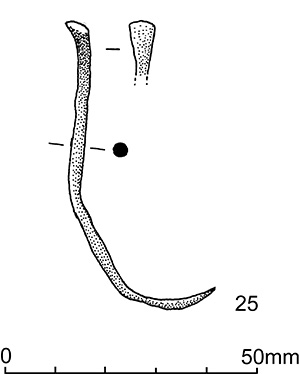
1. Copper alloy. Barbless fish-hook with a splayed terminal. In poor condition, slightly distorted. L. 30mm. SF5786, Fill 10922, Pit 10953, Group 673, Area N, Period 4
Internet Archaeology is an open access journal based in the Department of Archaeology, University of York. Except where otherwise noted, content from this work may be used under the terms of the Creative Commons Attribution 3.0 (CC BY) Unported licence, which permits unrestricted use, distribution, and reproduction in any medium, provided that attribution to the author(s), the title of the work, the Internet Archaeology journal and the relevant URL/DOI are given.
Terms and Conditions | Legal Statements | Privacy Policy | Cookies Policy | Citing Internet Archaeology
Internet Archaeology content is preserved for the long term with the Archaeology Data Service. Help sustain and support open access publication by donating to our Open Access Archaeology Fund.